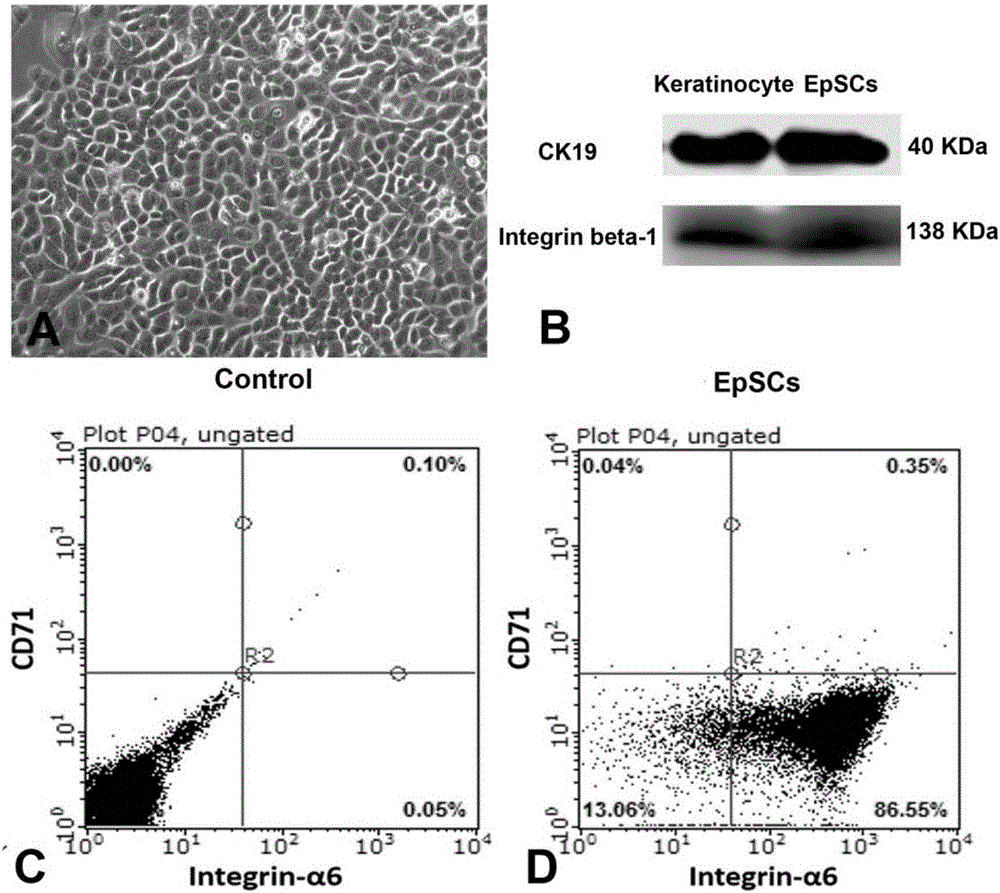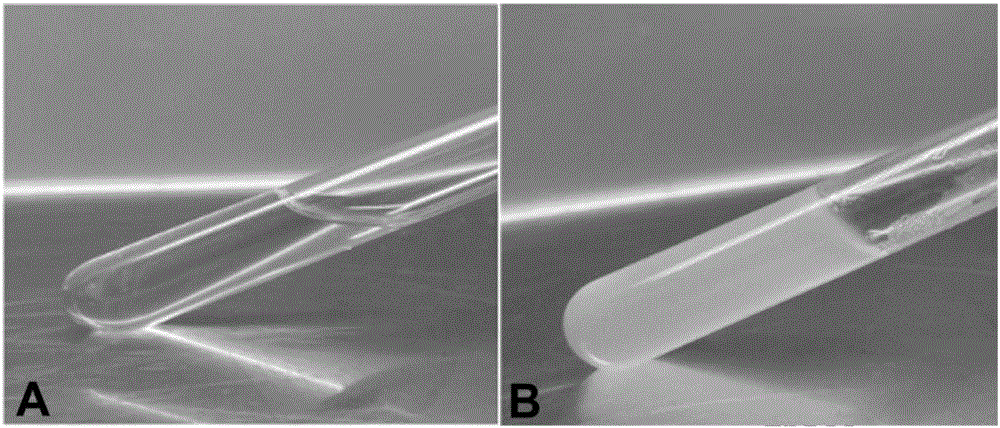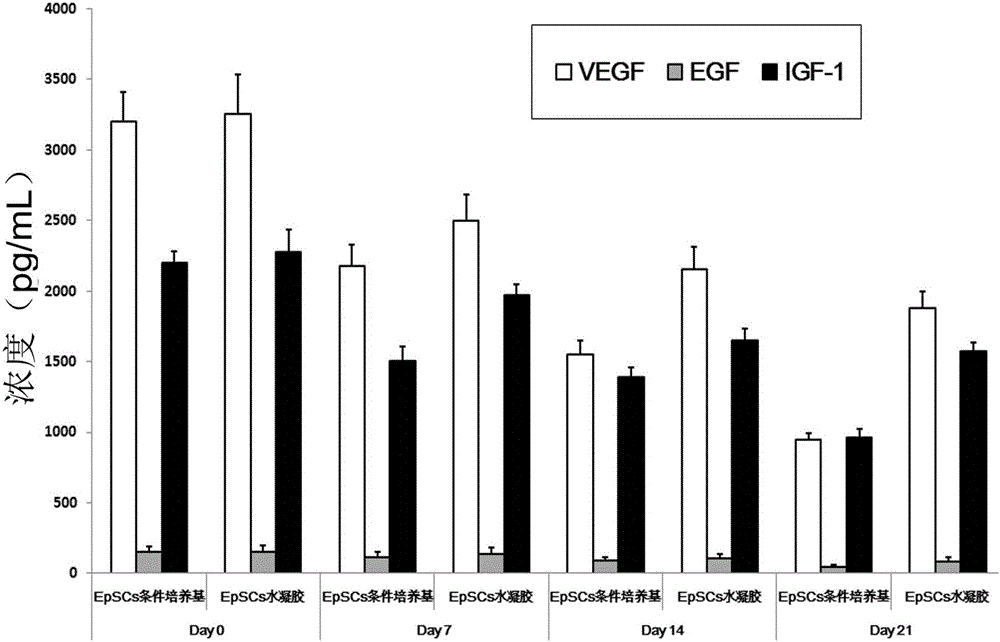Thermo-sensitive hydrogel and preparation method thereof
A temperature-sensitive hydrogel and collagen technology, applied in the field of temperature-sensitive hydrogel and its preparation, can solve the problems of short half-life of cytokines and the like
- Summary
- Abstract
- Description
- Claims
- Application Information
AI Technical Summary
Problems solved by technology
Method used
Image
Examples
Embodiment 1
[0046] Example 1 Isolation and cultivation of epidermal stem cells EpSCs
[0047] experimental method:
[0048] 1) Rinse the freshly removed normal human skin with normal saline containing 100U / mL penicillin and streptomycin 10 times, cut into a skin piece of about 5mm×5mm, remove the subcutaneous fat tissue and separate the epidermis and dermis After obtaining the epidermal tissue, cut it into 1mm×1mm pieces again;
[0049] 2) Add 0.25% trypsin-PBS solution to the epidermis fragments to digest for 30 minutes, add EpSCs primary culture medium to stop digestion, and filter with a 100 μm filter after blowing; the filtrate is centrifuged at 1000r / min for 10 minutes, and the cell pellet is added to EpSCs primary culture medium (K-SFM medium, containing 10ng / ml of EGF, 2ng / ml of FGF and IGF-1, 30μg / ml of BPE, 0.05mM of CaCl 2 , 0.5μg / mL hydrocortisone, 100U / ml penicillin-streptomycin) to make 3×10 5 / ml of single-cell suspension, inoculated in a culture dish pre-coated with type...
Embodiment 2
[0052] The preparation of embodiment 2 thermosensitive hydrogel
[0053] (1), preparation of epidermal stem cell conditioned medium: take the well-grown EpSC adherent cells of the 4th generation of culture, and when the fusion rate reaches 70-80%, the full amount of liquid is replaced with fresh EpSCs subculture medium. After 36 hours, collect the culture medium, centrifuge at 3000r / min for 30min to remove cell debris, filter and sterilize with a 0.22μm filter membrane, and use it as the EpSC conditioned medium;
[0054] (2), preparation of cytokine activity stabilizer: chitosan powder is dissolved in the hydrochloric acid solution of 0.1mol / L, makes the chitosan solution of 2% (W / V), then adds mannitol powder to make it The final concentration is 0.25%, then add polyethylene glycol powder to make the final concentration 1%, then add macromolecular hyaluronic acid with a molecular weight of 1.2-1.4 million to make the final concentration 0.5% (W / V), then add seaweed NaOH so t...
Embodiment 3
[0058] Example 3 Thermosensitive hydrogel maintains the activity of cytokines
[0059] (1) Put the temperature-sensitive hydrogel obtained in Example 2 in an environment of 4°C, take a portion on the 0th, 7th, 14th, and 21st day, squeeze out the leachate, and use the ELISA method to detect VEGF, EGF, and IGF-1 content;
[0060] (2) Dilute the EpSC conditioned medium obtained in step (1) of Example 2 to one time, place it in a 4°C environment, take a portion on the 0th, 7th, 14th, and 21st day, and use ELISA method to detect VEGF , EGF, IGF-1 content;
[0061] Test results such as image 3 As shown, it can be seen that compared with the conditioned medium, the thermosensitive hydrogel of the present invention can better maintain the concentration of cytokines VEGF, EGF, and IGF-1 within 21 days.
PUM
 Login to View More
Login to View More Abstract
Description
Claims
Application Information
 Login to View More
Login to View More - R&D
- Intellectual Property
- Life Sciences
- Materials
- Tech Scout
- Unparalleled Data Quality
- Higher Quality Content
- 60% Fewer Hallucinations
Browse by: Latest US Patents, China's latest patents, Technical Efficacy Thesaurus, Application Domain, Technology Topic, Popular Technical Reports.
© 2025 PatSnap. All rights reserved.Legal|Privacy policy|Modern Slavery Act Transparency Statement|Sitemap|About US| Contact US: help@patsnap.com



